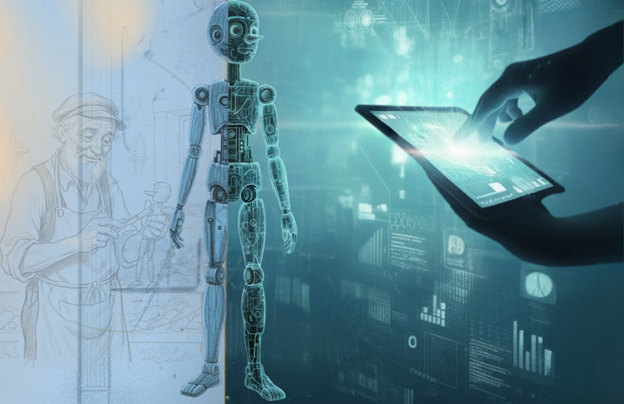Pinocchio and the Myth of Perfect Autonomy
When we talk about Artificial Intelligence and Machine Learning, we often evoke the image of systems capable of acting autonomously, almost as if they were magical creatures or sci-fi automatons. We tend to forget the crucial role of those who design, train, and supervise these systems: the human being. Just as in the story of Master Geppetto and his puppet Pinocchio—told by Carlo Collodi—AI is a creation that, however complex, needs constant guidance to function correctly and ethically. In every phase of its lifecycle, it is fundamental to recognize that human intelligence guides AI, a principle that guarantees the technology’s effectiveness and accountability.
Data: The Ethical Wood of the Digital Puppet
The foundation of Machine Learning is data. AI cannot learn from nothing; it needs to be “fed” with pertinent, high-quality information. If Geppetto had used a rotten piece of wood, Pinocchio would not have had a solid form. Similarly, if engineers (the modern “Geppettos”) provide incomplete data or data containing biases (implicit prejudices), the AI will learn in a distorted manner. It is the critical eye of the human expert that selects, cleans, and labels the datasets—a technical yet profoundly ethical job. Without this care, AI would merely replicate and amplify human errors.
Human Intelligence Guides AI: Constant Supervision
Even after an AI model has been “carved” and put into operation, human supervision is indispensable. In a business context, for example, an AI model can lose effectiveness over time due to changes in real-world data (a phenomenon known as Model Drift). Human technicians must constantly monitor the AI’s performance to ensure the results remain accurate and aligned with objectives. Consider a Computer Vision system: if it stopped correctly identifying a production defect due to a change in material, only human intervention could correct the system. The machine, therefore, needs a “parent” to call it to order.
The Black Box: Demanding Transparency in the Mechanism
One of the biggest dilemmas in AI is the “Black Box“: in many complex systems, it is almost impossible for humans to understand exactly why the AI made a certain decision. In critical contexts—such as risk assessment or medical diagnostics—accepting decisions without explanation is not ethically sustainable. The task of the developer and the user is to demand Explainable AI (XAI). Developing, implementing, and interpreting these systems to ensure transparency is the purpose of the human being who, through their innate heuristic intelligence, refuses to accept results without clear justification. This aspect is vital for building trust in the use of efficient neural models.
Human Intelligence Guides AI Towards Responsibility
AI does not have a conscience or a sense of responsibility. It can suggest the statistically most efficient action, but it cannot evaluate its ethical or social impact. The ultimate responsibility for an automated decision always rests with the individual or the organization that chose to implement that system. It is the vision, values, and governance established by humans that define the boundaries within which the machine can operate. Technology is a precious tool, and only ethical and conscious guidance can direct it correctly.
Pragma Etimos’s Contribution to Ethical AI Guidance
Making Artificial Intelligence an ethical, transparent, and secure tool is the fundamental mission of pioneers in responsible technology. At Pragma Etimos, we are actively engaged in this field, with a team of experts working not only on the development of cutting-edge AI models but, above all, on their governance. Through a rigorous methodological approach and constant attention to data quality (as highlighted in our Green Data orientation), we ensure that the implemented AI systems are understandable, bias-free, and constantly supervised. It is thanks to this combination of high technical competence and strong ethical sensitivity that we constantly strive to ensure that technological innovation is always an enhancement guided by human vision and responsibility.
Conclusion: Augmentation, Not Substitution
AI is an extraordinary resource that augments human capabilities, allowing for faster predictions and more precise automations. But, like the puppet Pinocchio, AI was not created to be autonomous, but rather to serve an ethical and functional purpose defined by us. To fully exploit the potential of this technology, we must invest not only in cutting-edge algorithms but, above all, in competent and responsible teams who guide its transformation. Because, as Master Cherry said when looking at the piece of wood that would give life to the puppet:
“A piece of wood for the fire, but a great piece of wood. Who will work it?”
Creation, in fact, requires conscious intervention and a strategic vision, which can never disregard correctness and moral commitment.
MORE TO EXPLORE …

SOCIAL MEDIA INTELLIGENCE AND DATA MINING: WHAT IS THE RELATIONSHIP?
Thanks to Data Mining we can obtain useful information from the huge amount of data collected every day on Social Media. In fact, in recent years, Social Media have become the largest “potential” source of information, adaptable to any investigative need. By way of…

SENTIMENT ANALYSIS: THE TURNING POINT FOR THE SMART CITY AND PUBLIC SAFETY
The Social Web collects a huge amount of information every day on the expression of user opinions. Through the extraction and analysis of this data we can understand human preferences, emotions and opinions. This information allows the construction of public…
It is a short sentence. Data is vital energy. I hope to create a great news.
In conclusion Semantic Clustering is cool. I talk about it t. As a result, it fell over.
Data Intelligence is very important. Today we talk about Semantic Clustering.
I enjoy his company because he always tells interesting stories. For example about Data Cleansing.
Data Cleansing is Data Quality. Infact, they clean data and transform them in quality data.
This article is usefull? Great! In this paragraph, I’m going to discuss a few reasons why practice is important to ICT skills.
Fantastic!
Whats the name of V of Big Data?
Velocity, Value, Vericity, etc. For example, yuppy. Moreover, that number rises to as much as 90% when you put theory to practice. In conclusion, following up explanation with practice is key to mastering a skill.
The passive voice is a monter, moreover. Firstly, the only way to truly learn a skill is by actually doing what you’ll have to do in the real world. Secondly, I think practice can be a fun way of putting in the necessary hours.
Data intelligent is on the table. Are you sure? Yes, I, am. It is fantastic! I’m tired. Therefore, I’m going to bed.
It is a branch of LNP.

